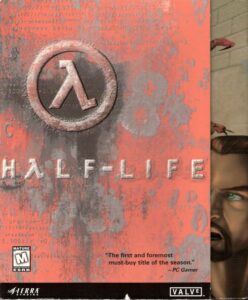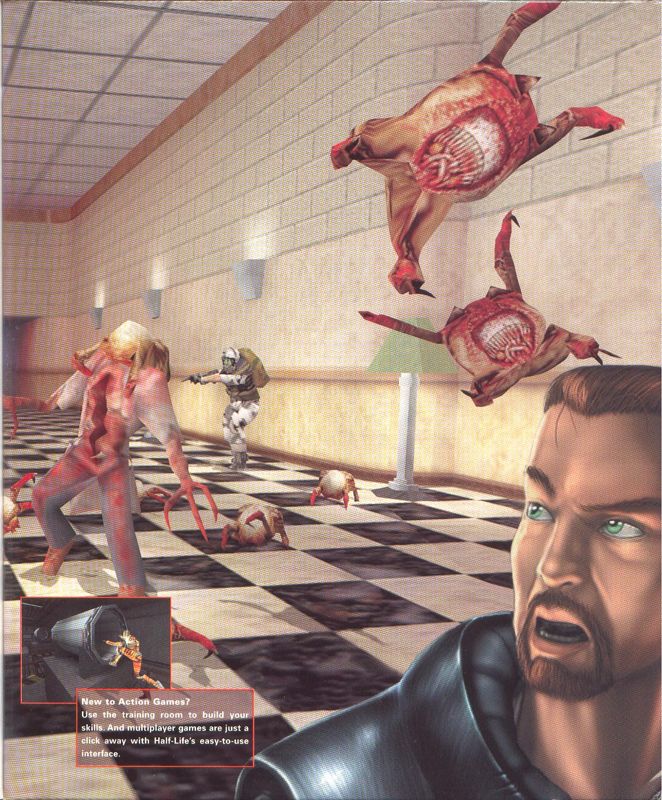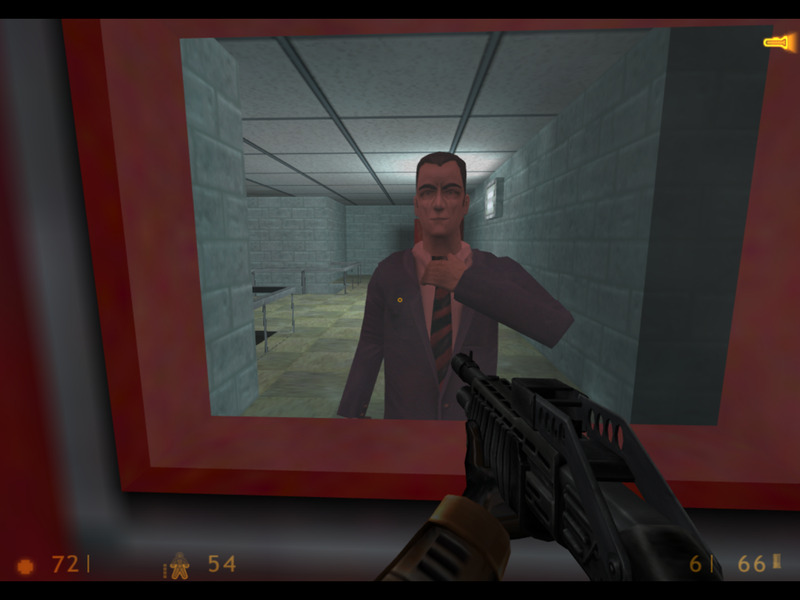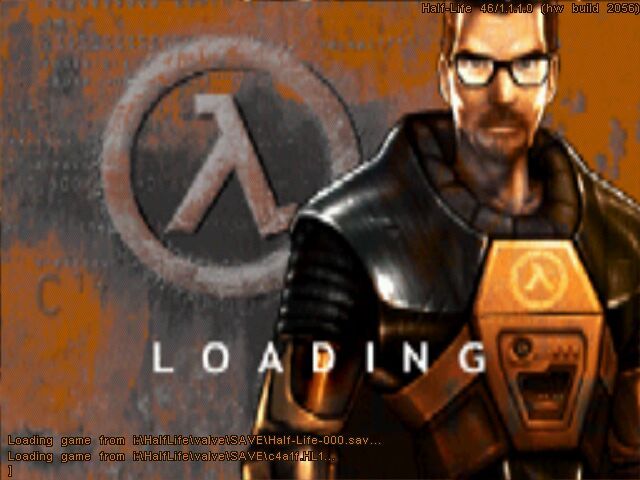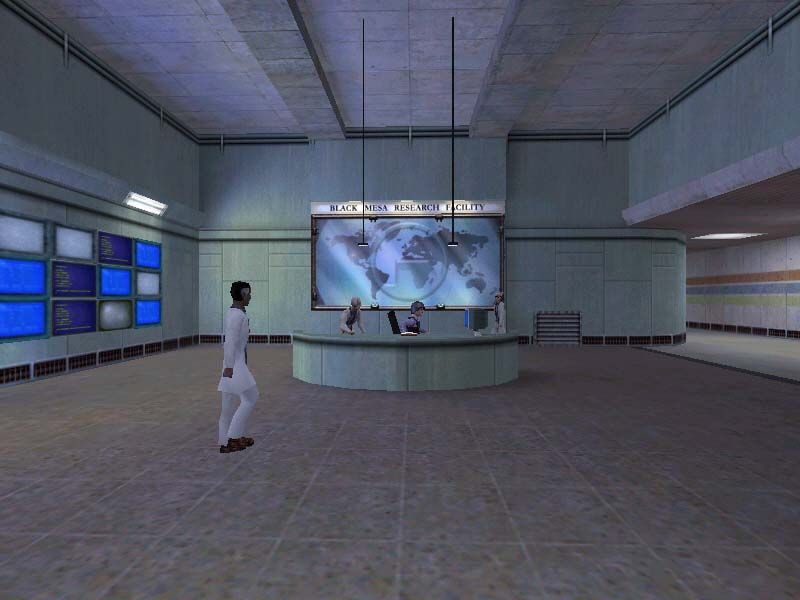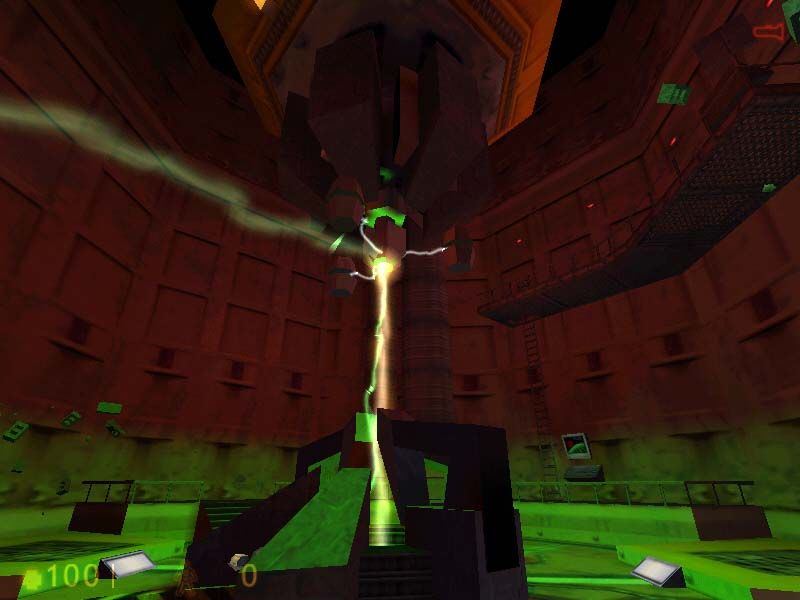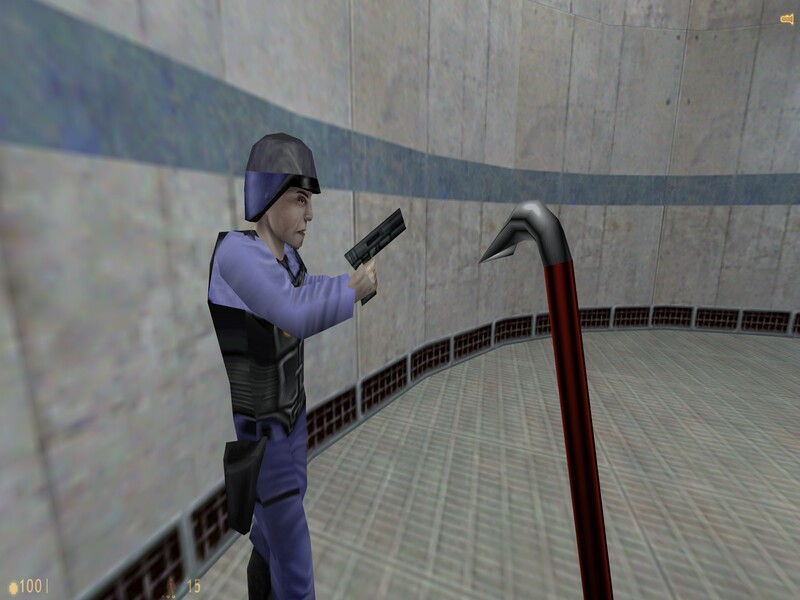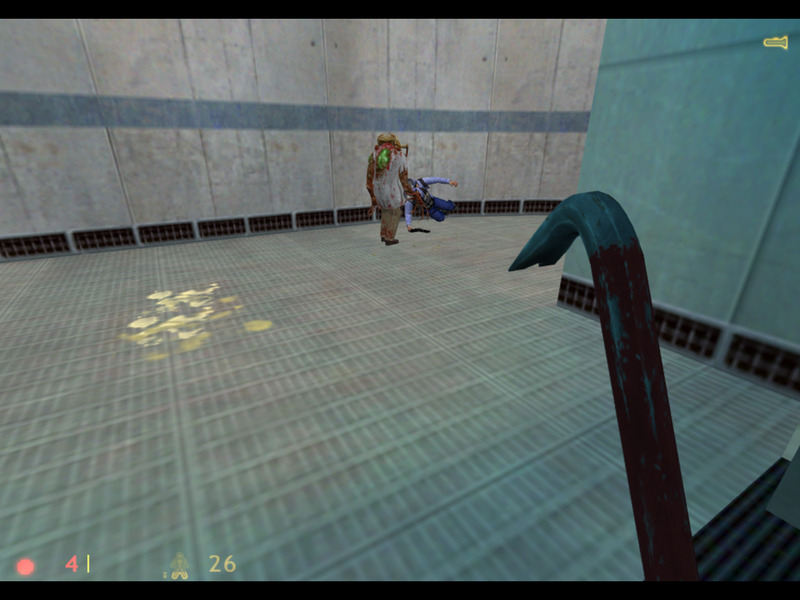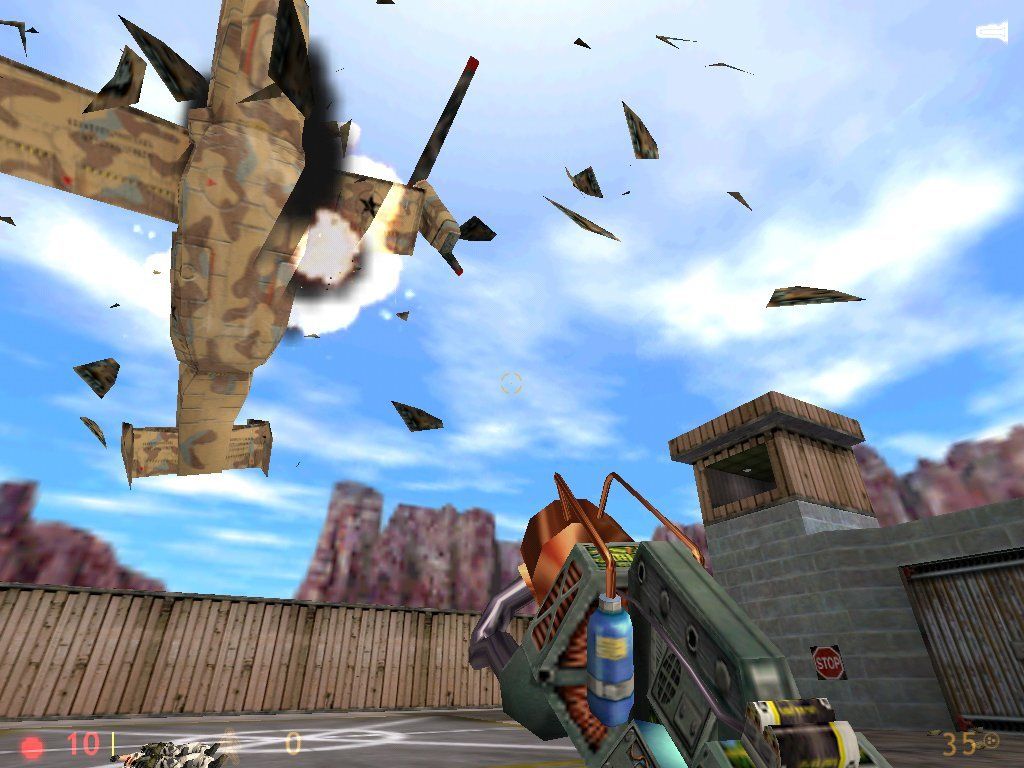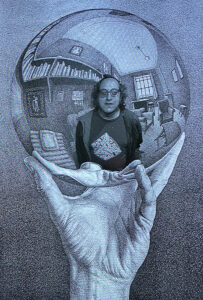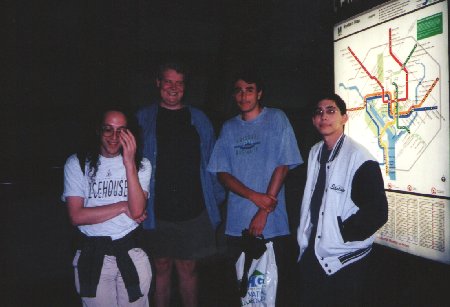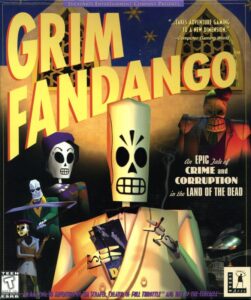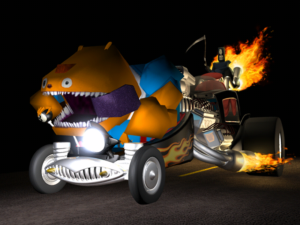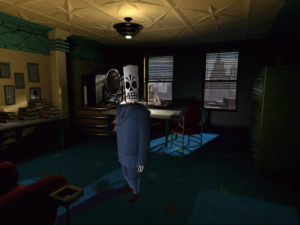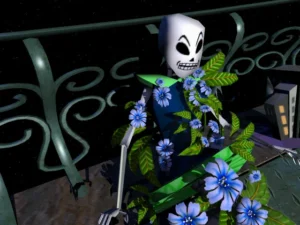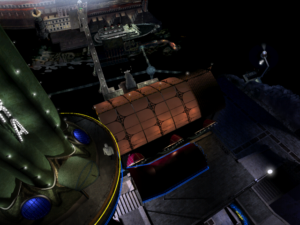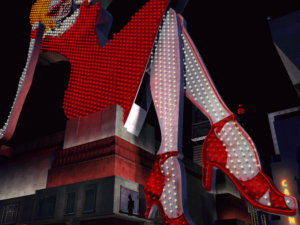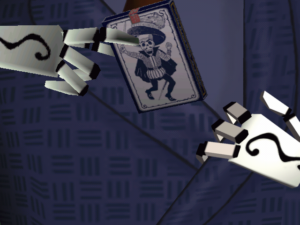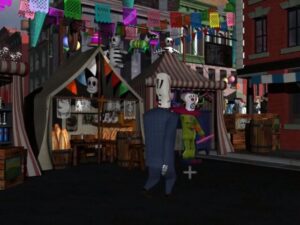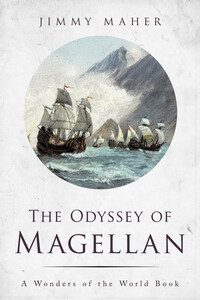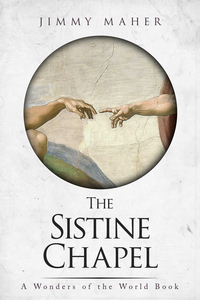Around twenty years ago, people would have laughed if you told them that videogames would end up at the Smithsonian, but the Half-Life team really did want to make games that were more than just throwaway toys. The rule against cinematics — which made our jobs much harder and also ended up leaving a lot of my favorite work out of the game — was a kind of ideological stake in the ground: we really did want the game and the story to be the same thing. It was far from flawless, but it was really trying to push the boundaries of a young medium.
— Valve artist Steve Theodore
By 1998, the first-person shooter was nearing its pinnacle of popularity. In June of that year, Computer Gaming World magazine could list fourteen reasonably big-budget, high-profile FPS’s earmarked for release in the next six months alone. And yet the FPS seemed rather to be running to stand still. Almost all of the innovation taking place in the space was in the realm of technology rather than design.
To be sure, progress in the former realm was continuing apace. Less than five years after id Software had shaken the world with DOOM, that game’s low-resolution 2.5D graphics and equally crude soundscapes had become positively quaint. Aided and abetted by a fast-evolving ecosystem of 3D-graphics hardware from companies like 3Dfx, id’s Quake engine had raised the bar enormously in 1996; ditto Quake II in 1997. These were the cutting-edge engines that everyone with hopes of selling a lot of shooters scrambled to license. Then, in May of 1998, with Quake III not scheduled for release until late the following year, Epic MegaGames came along with their own Unreal engine, boasting a considerably longer bullet list of graphical effects than Quake II. In thus directly challenging id’s heretofore unquestioned supremacy in the space, Unreal ignited a 3D-graphics arms race that seemed to promise even faster progress in the immediate future.
Yet whether they sported the name Quake or Unreal or something else on their boxes, single-player FPS’s were still content to hew to the “shooting gallery” design template laid out by DOOM. You were expected to march through a ladder-style campaign consisting of a set number of discrete levels, each successive one full of more and more deadly enemies to kill than the last, perhaps with some puzzles of the lock-and-key or button-mashing stripe to add a modicum of variety. These levels were joined together by some thread of story, sometimes more elaborate and sometimes — usually — less so, but so irrelevant to what occurred inside the levels that impatient gamers could and sometimes did skip right over the intervening cutscenes or other forms of exposition in order to get right back into the action.
This was clearly a model with which countless gamers were completely comfortable, one which had the virtue of allowing them maximal freedom of choice: follow along with the story or ignore it, as you liked. Or, as id’s star programmer John Carmack famously said: “Story in a game is like a story in a porn movie. It’s expected to be there, but it’s not that important.”
But what if you could build the story right into the gameplay, such that the two became inseparable? What if you could eliminate the artificial division between exposition and action, and with it the whole conceit of a game as a mere series of levels waiting to be beaten one by one? What if you could drop players into an open-ended space where the story was taking place all around them?
This was the thinking that animated an upstart newcomer to the games industry that went by the name of Valve L.L.C. The game that resulted from it would prove the most dramatic conceptual advance in the FPS genre since DOOM, with lessons and repercussions that reached well beyond the borders of shooter country.
The formation of Valve was one of several outcomes of a dawning realization inside the Microsoft of the mid-1990s that computer gaming was becoming a very big business. The same realization led a highly respected Microsoft programmer named Michael Abrash to quit his cushy job in Redmond, Washington, throw his tie into the nearest trashcan, and move to Mesquite, Texas, to help John Carmack and the other scruffy id boys make Quake. It led another insider named Alex St. John to put together the internal team who made DirectX, a library of code that allowed game developers and players to finally say farewell to creaky old MS-DOS and join the rest of the world that was running Windows 95. It led Microsoft to buy an outfit called Ensemble Studios and their promising real-time-strategy game Age of Empires as a first wedge for levering their way into the gaming market as a publisher of major note. And it led to Valve Corporation.
In 1996, Valve’s future co-founders Gabe Newell and Mike Harrington were both valued employees of Microsoft. Newell had been working there in project-management roles since 1983; he had played an important part in the creation of the early versions of Windows before moving on to Microsoft Office and other high-profile applications. Harrington was a programmer whose tenure had been shorter, but he had made significant contributions to Windows NT, Microsoft’s business- and server-oriented operating system.
As Newell tells the tale, he had an epiphany when he was asked to commission a study to find out just how many computers were currently running Microsoft Windows in the United States. The number of 20 million that he got back was impressive. Yet he was shocked to learn that Windows wasn’t the most popular single piece of software to be found on American personal computers; that was rather a game called DOOM. Newell and Harrington had long enjoyed playing games. Now, it seemed, there were huge piles of money to be earned from making them. Doing so struck them as a heck of a lot more fun than making more operating systems and business software. It was worth a shot, at any rate; both men were wealthy enough by now that they could afford to take a flier on something completely different.
So, on August, 24, 1996, the pair quit Microsoft to open an office for their new company Valve some five miles away in Kirkland, Washington. At the time, no one could have imagined — least of all them — what a milestone moment this would go down as in the history of gaming. “On the surface, we should have failed,” says Gabe Newell. “Realistically, both Mike and I thought we would get about a year into it, realize we’d made horrible mistakes, and go back to our friends at Microsoft and ask for our jobs back.”
Be that as it may, they did know what kind of game they wanted to make. Or rather Newell did; from the beginning, he was the driving creative and conceptual force, while Harrington focused more on the practical logistics of running a business and making quality software. Like so many others in the industry he was entering, Newell wanted to make a shooter. Yet he wanted his shooter to be more immersive and encompassing of its player than any of the ones that were currently out there, with a story that was embedded right into the gameplay rather than standing apart from it. Valve wasted no time in licensing id’s Quake engine to bring these aspirations to life, via the game that would come to be known as Half-Life.
As the id deal demonstrates, Newell and Harrington had connections and financial resources to hand that almost any other would-be game maker would have killed for; both had exited Microsoft as millionaires several times over. Yet they had no access to gaming distribution channels, meaning that they had to beat the bush for a publisher just like anyone else with a new studio. They soon found that their studio and their ambitious ideas were a harder sell than they had expected. With games becoming a bigger business every year, there were a lot of deep-pocketed folks from other fields jumping into the industry with plans to teach all of the people who were already there what they were doing wrong; such folks generally had no clue about what it took to do games right. Seasoned industry insiders had a name for these people, one that was usually thoroughly apt: “Tourists.” At first glance, the label was easy to apply to Newell and Harrington and Valve. Among those who did so was Mitch Lasky, then an executive at Activision, who would go on to become a legendary gaming venture capitalist. He got “a whiff of tourism” from Valve, he admits. He says he still has “post-traumatic stress disorder” over his decision to pass on signing them to a publishing deal — but by no means was he the only one to do so.
Newell and Harrington finally wound up pitching to Sierra, a publisher known primarily for point-and-click adventure games, a venerable genre that was now being sorely tested by all of the new FPS’s. In light of this, Sierra was understandably eager to find a horse of the new breed to back. The inking of a publishing deal with Valve was one of the last major decisions made by Ken Williams, who had founded Sierra in his living room back in 1980 but had recently sold the business he had built from the ground up. He wasn’t getting along very well with the buyers, and was already eying the exit. But for now, he was still taking meetings like this one.
As a man with such deep roots in adventure games, Williams found Valve’s focus on story both refreshing and appealing. Still, there was a lot of wrangling between the parties, mainly over the ultimate disposition of the rights to the Half-Life name; Williams wanted them to go to Sierra, but Newell and Harrington wanted to retain them for themselves. In the end, with no other publishers stepping up to the plate, Valve had to accept what Sierra was offering, a capitulation that would lead to a lengthy legal battle a few years down the road. For now, though, they had their publisher.
As for Ken Williams, who would exit the industry stage left well before Half-Life was finished:
Now that I’m retired, people sometimes ask me what I used to do. I usually just say, “I had a game company back in the old days.” That inevitably causes them to say, “Did you make any games I might have heard of?” I answer, “Leisure Suit Larry.” That normally is sufficient, but if there is no glimmer of recognition I pull out the heavy artillery and say, “Half-Life.” Unless they’ve been sleeping under a rock for the last couple of decades, that always lights up their eyes.
One can imagine worse codas to a business career…
In what could all too easily be read as another sign of naïve tourism, Newell and Harrington agreed to a crazily optimistic development timeline, promising a finished game for the Christmas of 1997, which was just one year away. To make it happen, they hired a few dozen level designers, programmers, artists, and other creative and technical types, many of whom had no prior professional experience in the games industry, all of whom recognized what an extraordinary opportunity they were being handed and were willing to work like dogs to make the most of it. The founders tapped a fertile pool of recruits in the online DOOM and Quake modding scenes, where amateurs were making names for themselves by bending those engines in all sorts of new directions. They would now do the same on a professional basis at Valve, even as the programmers modified the Quake engine itself to suit their needs, implementing better lighting and particle effects, and adding scripting and artificial-intelligence capabilities that the straightforward run-and-shoot gameplay in which id specialized had never demanded. Gabe Newell would estimate when all was said and done that 75 percent of the code in the engine had been written or rewritten at Valve.
In June of 1997, Valve took Half-Life to the big E3 trade show, where it competed for attention with a murderers’ row of other FPS’s, including early builds of Unreal, SiN, Daikatana, Quake II, and Jedi Knight. Valve didn’t even have a booth of their own at the show. Nor were they to be found inside Sierra’s; Half-Life was instead shown in the booth of 3Dfx. Like so many of Valve’s early moves, this one was deceptively clever, because 3Dfx was absolutely huge at the time, with as big a buzz around their hardware as id enjoyed around their software. Half-Life walked away from the show with the title of “Best Action Game.”
The validation of E3 made the unavoidable moment of reckoning that came soon after easier to stomach. I speak, of course, about the moment when Valve had to recognize that they didn’t have a ghost of a chance of finishing the game that they wanted to make within the next few months. Newell and Harrington looked at the state of the project and decided that they could probably scrape together a more or less acceptable but formulaic shooter in time for that coming Christmas. Or they could keep working and end up with something amazing for the next Christmas. To their eternal credit, they chose the latter course, a decision which was made possible only by their deep pockets. For Sierra, who were notorious for releasing half-finished games, certainly did not intend to pay for an extra year of development time. The co-founders would have to foot that bill themselves. Nevertheless, to hear Gabe Newell tell it today, it was a no-brainer: “Late is just for a little while. Suck is forever.”
The anticipation around Half-Life didn’t diminish in the months that followed, not even after the finished Unreal took the world by storm in May of 1998. Despite being based on a two-plus-year-old engine in a milieu that usually prized the technologically new and shiny above all else, Valve’s “shooter with a story” had well and truly captured the imaginations of gamers. During the summer of 1998, a demo of the game consisting of the first three chapters — including the now-iconic opening scenes, in which you ride a tram into a secret government research facility as just another scientist on the staff headed for another day on the job — leaked out of the offices of a magazine to which it had been sent. It did more to promote the game than a million dollars worth of advertising could have; the demo spread like wildfire online, raising the excitement level to an even more feverish pitch. Half-Life was different enough to have the frisson of novelty in the otherwise homogeneous culture of the FPS, whilst still being readily identifiable as an FPS. It was the perfect mix of innovation and familiarity.
So, it was no real surprise when the full game turned into a massive hit for Valve and Sierra after its release on November 19, 1998. The magazines fell all over themselves to praise it. Computer Gaming World, normally the closest thing the hype-driven journalism of gaming had to a voice of sobriety, got as high on Half-Life’s supply as anyone. The magazine’s long-serving associate editor Jeff Green took it upon himself to render the official verdict.
Everything you’ve heard, everything you’ve hoped for — it’s all true. Half-Life, Valve Software’s highly anticipated first-person shooter, is not just one of the best games of the year. It’s one of the best games of any year, an instant classic that is miles better than any of its immediate competition, and, in its single-player form, is the best shooter since DOOM. Plus, despite the fact that it’s “just” a shooter, Half-Life provides one of the best examples ever of how to present an interactive movie — and a great, scary movie at that.
Half-Life sold its first 200,000 copies in the United States before Christmas — i.e., before glowing reviews like the one above even hit the newsstands. But this was the barest beginning to its success story. In honor of its tenth birthday in 2008, Guinness of world-records fame would formally anoint Half-Life as the best-selling single FPS in history, with total sales in the neighborhood of 10 million copies across all platforms and countries. For Newell and Harrington, it was one hell of a way to launch a game-development studio. For Sierra, who in truth had done very little for Half-Life beyond putting it in a box and shipping it out to stores, it was a tsunami of cash that seemed to come out of nowhere, the biggest game they had ever published almost by an order of magnitude. One does hope that somebody in the company’s new management took a moment to thank Ken Williams for this manna from heaven.
Half-Life has come to occupy such a hallowed, well-nigh sacrosanct position in the annals of gaming that any encounter with the actual artifact today seems bound to be slightly underwhelming. Yet even when we take into account the trouble that any game would have living up to a reputation as elevated as this one’s, the truth is that there’s quite a lot here for the modern skeptical critic to find fault with — and, Lord knows, this particular critic has seldom been accused of lacking in skepticism.
Judged purely as a shooter, the design shows its age. It’s sometimes amazingly inspired, but more often no better than average for its time. There’s a lot of crawling through anonymous vents that serve no real purpose other than to extend the length of the game, a lot of places where you can survive only by dying first so as to learn what’s coming, a lot of spots where it’s really not clear at all what the game wants from you. And then there are an awful lot of jumping puzzles, shoehorned into a game engine that has way more slop in it than is ideal for such things. I must say that I had more unadulterated fun with LucasArts’s Jedi Knight, the last shooter I played all the way through for these histories, than I did with Half-Life. There the levels are constructed like thrill rides straight out of the Star Wars films, with a through-line that seems to just intuitively come to you; looking back, I’m still in awe of their subtle genius in this respect. Half-Life is not like that. You really have to work to get through it, and that’s not as appealing to me.
Then again, my judgment on these things should, like that of any critic, be taken with a grain of salt. Whether you judge a game good or bad or mediocre hinges to a large degree on what precisely you’re looking for from it; we’ve all read countless negative reviews reflective not so much of a bad game as one that isn’t the game that that reviewer wanted to play. Personally, I’m very much a tourist in the land of the FPS. While I understand the appeal of the genre, I don’t want to expend too many hours or too much effort on it. I want to blast through a fun and engaging environment without too much friction. Make me feel like an awesome action hero while I’m at it, and I’ll probably walk away satisfied, ready to go play something else. Jedi Knight on easy mode gave me that experience; Half-Life did not, demanding a degree of careful attention from me that I wasn’t always eager to grant it. If you’re more hardcore about this genre than I am, your judgment of the positives and negatives in these things may very well be the opposite of mine. Certainly Half-Life is more typical of its era than Jedi Knight — an era when games like this were still accepted and even expected to be harder and more time-consuming than they are today. C’est la vie et vive la différence!
But of course, it wasn’t the granular tactical details of the design that made Half-Life stand out so much from the competition back in the day. It was rather its brilliance as a storytelling vehicle that led to its legendary reputation. And don’t worry, you definitely won’t see me quibbling that said reputation isn’t deserved. Even here, though, we do need to be sure that we understand exactly what it did and did not do that was so innovative at the time.
Contrary to its popular rep then and now, Half-Life was by no means the first “shooter with a story.” Technically speaking, even DOOM has a story, some prattle about a space station and a portal to Hell and a space marine who’s the only one that can stop the demon spawn. The story most certainly isn’t War and Peace, but it’s there.
Half-Life wasn’t even the shooter at the time of its release with the inarguably best or most complicated story. LucasArts makes a strong bid for the title there. Both Dark Forces and the aforementioned Jedi Knight, released in 1995 and 1997 respectively, weave fairly elaborate tales into the fabric of the existing Star Wars universe, drawing on its rich lore, inserting themselves into the established chronology of the original trilogy of films and the “Expanded Universe” series of Star Wars novels.
Like that of many games of this era, Half-Life’s story betrays the heavy influence of the television show The X-Files, which enjoyed its biggest season ever just before this game was released. We have the standard nefarious government conspiracy involving extraterrestrials, set in the standard top-secret military installation somewhere in the Desert Southwest. We even have a direct equivalent to Cancer Man, The X-Files’s shadowy, nameless villain who is constantly lurking behind the scenes. “G-Man” does the same in Half-Life; voice actor Michael Shapiro even opted to give him a “lizard voice” that’s almost a dead ringer for Cancer Man’s nicotine-addled croak.
All told, Half-Life’s story is more of a collection of tropes than a serious exercise in fictional world-building. To be clear, the sketchiness is by no means an automatically bad thing, not when it’s judged in the light of the purpose the story actually needs to serve. Mark Laidlaw, the sometime science-fiction novelist who wrote the script, makes no bones about the limits to his ambitions for it. “You don’t have to write the whole story,” he says. “Because it’s a conspiracy plot, everybody knows more about it than you do. So you don’t have to answer those questions. Just keep raising questions.”
Once the shooting starts, plot-related things happen, but it’s all heat-of-the-moment stuff. You fight your way out of the complex after its been overrun by alien invaders coming through a trans-dimensional gate that’s been inadvertently opened, only to find that your own government is now as bent on killing you as the aliens are in the name of the disposal of evidence. Eventually, in a plot point weirdly reminiscent of DOOM, you have to teleport yourself onto the aliens’ world to shut down the portal they’re using to reach yours.
Suffice to say that, while Half-Life may be slightly further along the continuum toward War and Peace than DOOM is, it’s only slightly so. Countless better, richer, deeper stories were told in games before this one came along. When people talk about Half-Life as “the FPS with a story,” they’re really talking about something more subtle: about its way of presenting its story. Far from diminishing the game, this makes it more important, across genres well beyond the FPS. The best way for us to start to come to grips with what Half-Life did that was so extraordinary might be to look back to the way games were deploying their stories before its arrival on the scene.
Throughout the 1980s, story in games was largely confined to the axiomatically narrative-heavy genres of the adventure game and the CRPG. Then, in 1990, Origin Systems released Chris Roberts’s Wing Commander, a game which was as revolutionary in the context of its own time as Half-Life was in its. In terms of gameplay, Wing Commander was a “simulation” of outer-space dog-fighting, not all that far removed in spirit from the classic Elite. What made it stand out was what happened when you weren’t behind the controls of your space fighter. Between missions, you hung out in the officers’ lounge aboard your mother ship, collecting scuttlebutt from the bartender, even flirting with the fetching female pilot in your squadron. When you went into the briefing room to learn about your next mission, you also learned about the effect your last one had had on the unfolding war against the deadly alien Kilrathi, and were given a broader picture of the latest developments in the conflict that necessitated this latest flight into danger. The missions themselves remained shooting galleries, but the story that was woven around them gave them resonance, made you feel like you were a part of something much grander. Almost equally importantly, this “campaign” provided an easy way to structure your time in the game and chart your improving skills; beat all of the missions in the campaign and see the story to its end, and you could say that you had mastered the game as a whole.
People loved this; Wing Commander became by far the most popular computer-gaming franchise of the young decade prior to the smashing arrival of DOOM at the end of 1993. The approach it pioneered quickly spread across virtually all gaming genres. In particular, both the first-person-shooter and the real-time strategy genres — the two that would dominate over all others in the second half of the decade — adopted it as their model for the single-player experience. Even at its most rudimentary, a ladder-style campaign gave you a goal to pursue and a framework of progression to hang your hat on.
Yet the same approach created a weirdly rigid division between gameplay and exposition, not only on the playing side of the ledger but to a large extent on the development side as well. It wasn’t unusual for completely separate teams to be charged with making the gameplay part of a game and all of the narrative pomp and circumstance that justified it. The disconnect could sometimes verge on hilarious; in Jedi Knight, which went so far as to film real humans acting out a B-grade Star Wars movie between its levels, the protagonist has a beard in the cutscenes but is clean-shaven during the levels. By the late 1990s, the pre-rendered-3D or filmed-live-action cutscenes sometimes cost more to produce than the game itself, and almost always filled more of the space on the CD.
As he was setting up his team at Valve, Gabe Newell attempted to eliminate this weird bifurcation between narrative and gameplay by passing down two edicts to his employees, the only non-negotiable rules he would ever impose upon them. Half-Life had to have a story — not necessarily one worthy of a film or a novel, but one worthy of the name. And at the same time, it couldn’t ever, under any conditions, from the very first moment to the very last, take control out of the hands of the player. Everything that followed cascaded from these two simple rules, which many a game maker of the time would surely have seen as mutually contradictory. To state the two most obvious and celebrated results, they meant no cutscenes whatsoever and no externally imposed ladder of levels to progress through — for any sort of level break did mean taking control out of the hands of the player, no matter how briefly.
Adapting to such a paradigm the Quake engine, which had been designed with a traditional FPS campaign in mind, proved taxing but achievable. Valve set up the world of Half-Life as a spatial grid of “levels” that were now better described as zones; pass over a boundary from one zone into another, and the new one would be loaded in swiftly and almost transparently. Valve kept the discrete zones small so as to minimize the loading times, judging more but shorter loading breaks to be better than fewer but longer ones. The hardest part was dealing with the borderlands, so to speak; you needed to be able to look into one zone from another, and the enemies and allies around you had to stay consistent before and after a transition. But Valve managed even this through some clever technical sleight of hand — such as by creating overlapping areas that existed in both of the adjoining sets of level data — and through more of the same on the design side, such as by placing the borders whenever possible at corners in corridors and at other spots where the line of sight didn’t extend too far. The occasional brief loading message aside — and they’re very brief, or even effectively nonexistent, on modern hardware — Half-Life really does feel like it all takes place in the same contiguous space.
Every detail of Half-Life has been analyzed at extensive, exhaustive length over the decades since its release. Such analysis has its place in fan culture, but it can be more confusing than clarifying when it comes to appreciating the game’s most important achievements. The ironic fact is that you can learn almost everything that really matters about Half-Life as a game design just by playing it for an hour or so, enough to get into its third chapter. Shall we do so together now?
Half-Life hews to Gabe Newell’s guiding rules from the moment you click the “New Game” button on the main menu and the iconic tram ride into the Black Mesa Research Center begins. The opening credits play over this sequence, in which you are allowed to move around and look where you like. There are reports that many gamers back in the day didn’t actually realize that they were already in control of the protagonist — reports that they just sat there patiently waiting for the “cutscene” to finish, so ingrained was the status quo of bifurcation.
The protagonist himself strikes an artful balance between being an undefined player stand-in — what Zork: Grand Inquisitor called an “AFGNCAAP,” or “Ageless, Faceless, Gender-Neutral, Culturally Ambiguous Adventure Person” — and a fully fleshed-out character. As another result of Newell’s guiding rules, you never see him in the game unless you look in a mirror; you only see the world through his eyes. You do, however, hear security guards and colleagues refer to him — or, if you like, to you — as “Gordon” or “Mr. Freeman.” The manual and the intertitles that appear over the opening sequence of the game explain that his full name is indeed Gordon Freeman, and that he’s a 27-year-old theoretical physicist with a PhD from MIT who has been recently hired to work at Black Mesa. The game’s loading screen and its box art show us a rather atypical FPS protagonist, someone very different from the muscle-bound, cigar-chomping Duke Nukem or the cocky budding Jedi knight Kyle Katarn: a slim, studious-looking fellow with Coke-bottle eyeglasses and a token goatee. The heart of the computer-gaming demographic being what it was in 1998, he was disarmingly easy for many of the first players of Half-Life to identify with, thus adding just that one more note of immersion to the symphony. Small wonder that he has remained a favorite with cosplayers for decades. In fact, cipher though he almost entirely is, Gordon Freeman has become one of the most famous videogame characters in history.
The tram eventually arrives at its destination and a security guard welcomes you to the part of the complex where you work: “Morning, Mr. Freeman. Looks like you’re running late.” Passing through the double blast doors, you learn from your colleagues inside that it’s already been a rough morning: the main computer has crashed, which has thrown a wrench into an important test that was planned for today. Mind you, you don’t learn this through dialog menus, which Valve judged to qualify as taking control away from the player. You can’t speak at all, but if you approach the guards and scientists, they’ll say things to you, leaving you to imagine your own role in the conversation. Or you can stand back and listen to the conversations they have with one another.
You can wander around as you like in this office area. You can look in Gordon’s locker to learn a little bit more about him, buy a snack from the vending machine, even blow it up by microwaving it for too long. (“My God!” says your colleague in reaction. “What are you doing?”) All of this inculcates the sense of a lived-in workspace better than any amount of external exposition could have done, setting up a potent contrast with the havoc to come.
When you get bored fooling around with lockers and microwaves, you put on your hazardous-environment suit and head down to where the day’s test is to be conducted. It isn’t made clear to you the player just what the test is meant to accomplish; it isn’t even clear that Gordon himself understands the entirety of the research project to which he’s been assigned. All that matters is that the test goes horribly wrong, creating a “resonance cascade event” that’s accompanied by a lot of scary-looking energy beams flying through the air and explosions popping off everywhere. You’ve now reached the end of the second chapter without ever touching a weapon. But that’s about to change, because you’re about to find out that hostile alien lifeforms are now swarming the place. “Get to the surface as soon as you can and let someone know we’re stranded down here!” demand your colleagues. So, you pick up the handy crowbar you find lying on the floor and set off to batter a path through the opposition.
This was a drill with which 1990s shooter fans were a lot more familiar, but there are still plenty of new wrinkles. The scientists and guards who were present in the complex before all hell broke loose don’t just disappear. They’re still around, mostly cowering in the corners in the case of the former, doing their best to fight back in that of the latter. The scientists sometimes have vital information to share, while the guards will join you as full-blown allies, firing off their pop-gun pistols at your side, although they tend not to live very long. Allies were a new thing under the FPS sun in 1998, an idea that would quickly spread to other games. (Ditto the way that the guards here are almost better at shooting you in the back than they are at shooting the rampaging aliens. The full history of “allies” in the FPS genre is a fraught one…)
As you battle your way up through the complex, you witness plenty of pre-scripted scenes to go along with the emergent behavior of the scientists, guards, and aliens. Ideally, you won’t consciously notice any distinction between the two. You see a scientist being transformed into a zombie by an alien “head crab” behind the window of his office; see several hapless sad sacks tumbling down an open elevator shaft; see a dying guard trying and just failing to reach a healing station. These not only add to the terror and drama, but sometimes have a teaching function. The dying guard, for example, points out to you the presence of healing stations for ensuring that you don’t come to share his fate.
It’s the combination of emergent and scripted behaviors, on the part of your enemies and even more on that of your friends, that makes Half-Life come so vividly alive. I’m tempted to use the word “realism” here, but I know that Gabe Newell would rush to correct me if I did. Realism, he would say, is boring. Realistically, a guy like Gordon Freeman — heck, even one like Duke Nukem — wouldn’t last ten minutes in a situation like this one. Call it verisimilitude instead, a sign of a game that’s absolutely determined to stay true to its fictional premise, never mind how outlandish it is. The world Half-Life presents really is a living one; Newell’s rule of thumb was that five seconds should never pass without something happening near the player. Likewise, the world has to react to anything the player does. “If I shoot the wall, the wall should change, you know?” Newell said. “Similarly, if I were to throw a grenade at a grunt, he should react to it, right? I mean, he should run away from it or lay down on the ground and duck for cover. If he can’t run away from it, he should yell ‘Shit!’ or ‘Fire in the hole!’ or something like that.” In Half-Life, he will indeed do one or all of these things.
The commitment to verisimilitude means that most of what you see and hear is, to use the language of film, diegetic, or internal to the world as Gordon Freeman is experiencing it. Even the onscreen HUD is the one that Gordon is seeing, being the one that’s built into his hazard suit. The exceptions to the diegetic rule are few: the musical soundtrack that plays behind your exploits; the chapter names and titles which flash on the screen from time to time; those credits that are superimposed over the tram ride at the very beginning. These exceptions notwithstanding, the game’s determination to immerse you in an almost purely diegetic sensory bubble is the reason I have to strongly differ with Jeff Green’s description of Half-Life as an “interactive movie.” It’s actually the polar opposite of such a stylized beast. It’s an exercise in raw immersion which seeks to eliminate any barriers between you and your lived experience rather than making you feel like you’re doing anything so passive as watching or even guiding a movie. One might go so far as to take Half-Life as a sign that gaming was finally growing up and learning to stand on its own two feet by 1998, no longer needing to take so many of its cues from other forms of media.
We’ve about reached the end of our hour in Half-Life now, so we can dispense with the blow-by-blow. This is not to say that we’ve seen all the game has to offer. Betwixt and between the sequences that I find somewhat tedious going are more jaw-dropping dramatic peaks: the moment when you reach the exit to the complex at long last, only to learn that the United States Army wants to terminate rather than rescue you; the moment when you discover a tram much like the one you arrived on and realize that you can drive it through the tunnels; the moment when you burst out of the complex completely and see the bright blue desert sky above. (Unfortunately, it’s partially blotted out by a big Marine helicopter that also wants to kill you).
In my opinion, Half-Life could have been an even better game if it had been about half as long, made up of only its most innovative and stirring moments — “all killer, no filler,” as they used to say in the music business. Alas, the marketplace realities of game distribution in the late 1990s militated against this. If you were going to charge a punter $40 or $50 for a boxed game, you had to make sure it lasted more than six or seven hours. If Half-Life was being made today, Valve might very well have made different choices.
Again, though, mileages will vary when it comes to these things. The one place where Half-Life does fall down fairly undeniably is right at the end. Your climactic journey into Xen, the world of the aliens, is so truncated by time and budget considerations as to be barely there at all, being little more than a series of (infuriating) jumping puzzles and a couple of boss fights. Tellingly, it’s here that Half-Life gives in at last and violates its own rules of engagement, by delivering — perish the thought! — a cutscene containing the last bits of exposition that Valve didn’t have time to shoehorn into their game proper. The folks from Valve almost universally name the trip to Xen as their biggest single regret, saying they wish they had either found a way to do it properly or just saved it for a sequel. Needless to say, I can only concur.
Yet the fact remains that Half-Life at its best is so audacious and so groundbreaking that it almost transcends such complaints. Its innovations have echoed down across decades and genres. We’ll be bearing witness to that again and again in the years to come as we continue our journey through gaming history. Longtime readers of this site will know that I’m very sparing in my use of words like “revolutionary.” But I feel no reluctance whatsoever to apply the word to this game.
Did you enjoy this article? If so, please think about pitching in to help me make many more like it. You can pledge any amount you like.
Sources: The books Rocket Jump: Quake and the Golden Age of First-Person Shooters by David L. Craddock, Masters of DOOM: How Two Guys Created an Empire and Transformed Pop Culture by David Kushner, Not All Fairy Tales Have Happy Endings: The Rise and Fall of Sierra On-Line by Ken Williams, and Game Design: Theory & Practice (2nd edition) by Richard Rouse III. Retro Gamer 149; the GamesTM special issue “Trigger Happy”; Next Generation of December 1998, April 1999, and June 1999; Computer Gaming World of June 1998, December 1998, and February 1999; Sierra’s newsletter InterAction of Fall 1997; Gamers’ Republic of September 1998.
Online sources include “Full Steam Ahead: The History of Valve” by Jeff Dunn at Games Radar, “The Final Hours of Half-Life 2” by Geoff Keighley at GameSpot, and Soren Johnson’s interview of Mitch Latsky on his Designer Notes podcast.
Where to Get It: Half-Life is available for digital purchase on Steam.
